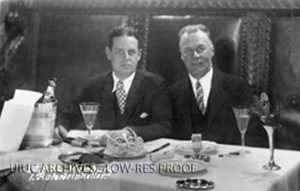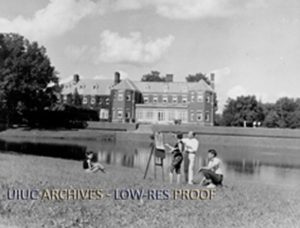
Written by Caitlin E. Crane
Some 30 miles to the southwest of the University of Illinois lies approximately 6,000 acres of farmland and prairies; of formal gardens and statues. The site is known as Allerton Park and Retreat Center, and is the former estate of Robert Allerton, a multimillionaire who donated the Park to the University of Illinois in 1946. The gift, which more than doubled the University’s land holdings at the time, lies 5 miles to south of Monticello, IL [1]. Today, Allerton Park and Retreat Center, otherwise simply called ‘Allerton’, has evolved into a site which is used by the University for conferences, retreats, and educational purposes. The University Archives holds multiple collections related to Allerton, including but not limited to, the Allerton Family Collection (R.S. 31/13/20); the Allerton Park Collection (R.S. 31/13/5); and the Robert Allerton Park Brochures and Newsletters (R.S. 31/13/805)

Robert Allerton, born on March 20, 1873 in Chicago, was given the land for what would later become Allerton Park by his father, Samuel Allerton. The elder Allerton had made his fortune, of which the younger Allerton later inherited a portion, in livestock, banking, and through investments in land and stockyards throughout the United States. Robert Allerton aspired to be an artist, and cultivated his interested in art as student at the Royal Academy in Munich and at the Academy Julien in Paris [2]. Allerton returned to Europe in 1898 to search for inspiration for the mansion he hoped to construct on the Monticello land tract gifted to him by his father. He found this inspiration in Ham House, the seat of the Earl of Dysart just outside London [2]. Architect John Bori(e) completed the Georgian-inspired house for Allerton in 1900 [3].

Robert Allerton’s involvement with the University of Illinois began in 1921, when he was invited to a housewarming party by the Zeta Psi fraternity on campus. There, he met John Wyatt Gregg, a 1926 graduate of the University [1], with whom he shared a close personal relationship for nearly 50 years. Indeed, Allerton would later go on to adopt Gregg in 1959 [2]. Allerton continued his relationship with University, establishing traveling scholarships in 1926 for architecture students at the school, and inviting the senior architecture students to his estate for an annual open house. He also served on the University’s planning board in 1923 [1].

The ties between Allerton and the University would be firmly cemented with his 1946 gift. The property which he gifted to the University included not only his home, but also the formal gardens Allerton and Gregg had cultivated. These gardens were dotted with artwork Allerton collected during his extensive travels, which Gregg accompanied him on in later years. This artwork includes both reproductions and original works, including statues of various mythological figures such as Chinese and Korean Fu Dogs; Italian caryatids; and Roman goddesses. Significant art pieces featured on the property include Emile-Anotine Bourdelle’s The Death of the Last Centaur statue of gold-embedded bronze; Carl Milles’ bronze The Sun Singer; and a bronze casting of Auguste Rodin’s Adam [4]. The property also contained a significant acreage of natural wilderness, including portions of the Sangamon River, floodplains, forests, and bluegrass sod meadows [5].

Robert Allerton’s gift continues to supply University of Illinois students, faculty, and staff with inspiration and opportunities for research and engagement. Research by University of Illinois faculty and students is ongoing in the Park’s natural areas, and research was recently expanded to include studies on sustainable systems in the Park. Allerton Park also works with campus groups like Learning in Community (LINC), Illinois Solar Decathlon, and the School of Music [6]. Students in ENG 312: LINC have recently worked on projects with Allerton including assisting with the construction of an 11,000 Watt solar installation [7] and building a 15-foot boardwalk on Allerton trails [8]. The School of Music partners with Allerton to host the annual Allerton Barn Music Festival, which offers performances within a traditional two-story Dutch hay barn on the Park’s grounds. Incoming students in the Natural Resources and Environmental Sciences program also take an annual field trip to visit Allerton [6]. The University Archives’ collections document the creation and growth of Allerton Park and Retreat Center – a gift to the University which is still enriching the lives of Illinois students.
[1] Myers, Fran (June 18, 1946). “Grounds About Mansion to be Public Park.” The Champaign News-Gazette. Retrieved from: http://tinyurl.com/ox4go64.
[2] Morgan, Jessie Borror (1968). The good life in Piatt County; a history of Piatt County, Illinois. Moline, IL: Desaulniers. Retrieved from: http://tinyurl.com/ox4go64.
[3] Priebe, Irene Pierson and Elmer Priebe (n.d.). “Allerton Park History.” Retrieved from: http://tinyurl.com/ox4go64.
[4] Scheinman, Muriel (1995). A Guide to the Art at the University of Illinois: Urbana-Champaign, Robert Allerton Park, and Chicago. Urbana, IL: University of Illinois Press.
[5] Allerton Park and Retreat Center (n.d). http://allerton.illinois.edu/ The University of Illinois at Urbana-Champaign.
[6] Peterson, Derek (2015). Personal communication.
[7] Hoffman, Steve (Nov. 12, 2013). “U of I student help build Boardwalk at Allerton.” The Piatt County Journal-Republican.
[8] The students of ENG 315: Learning in Community – Allerton Park (Nov. 7, 2013). “Allerton LINC to Campus.” Rediscover Allerton. Retrieved from: http://allerton.illinois.edu/allerton-linc-to-campus/
